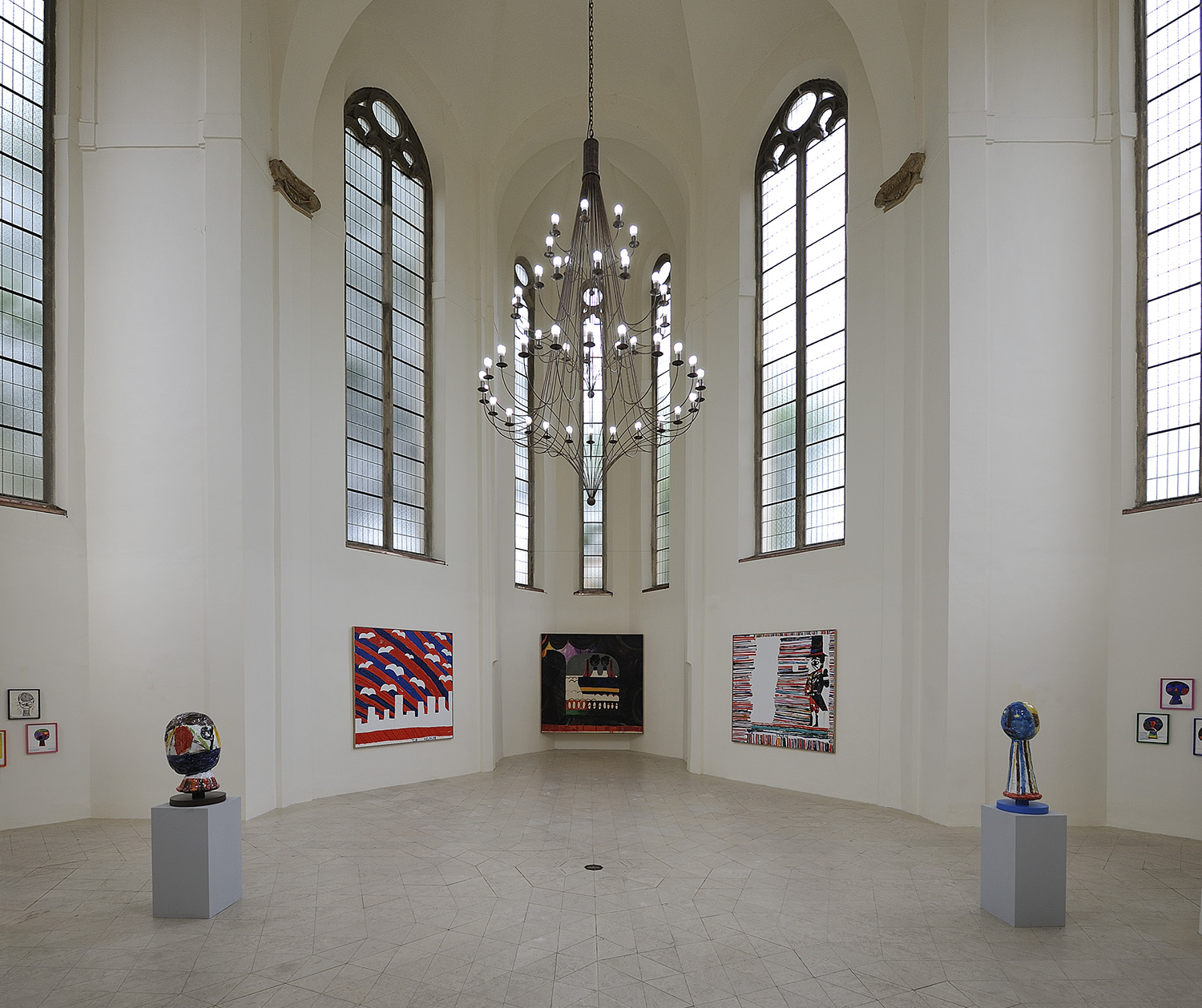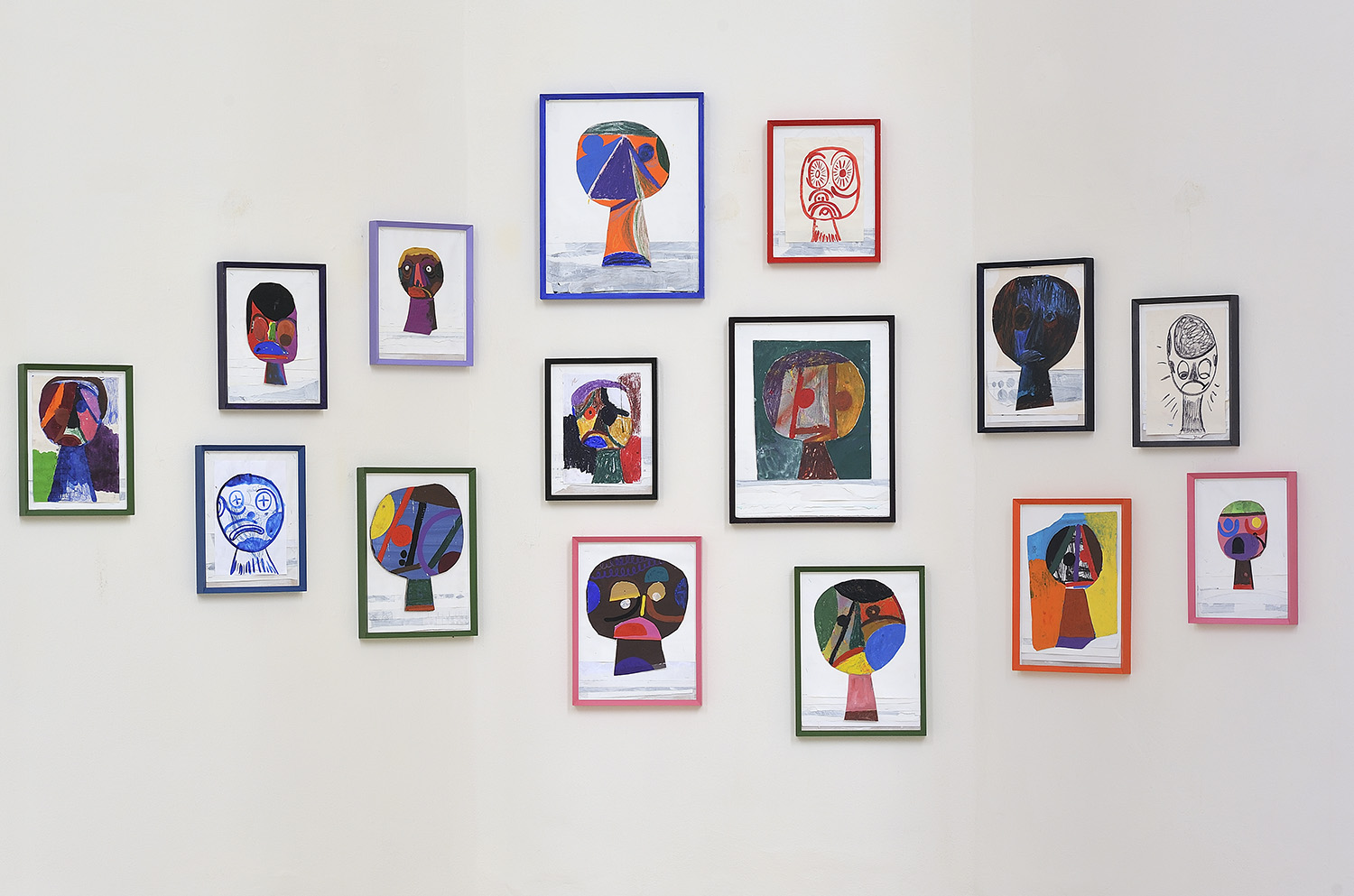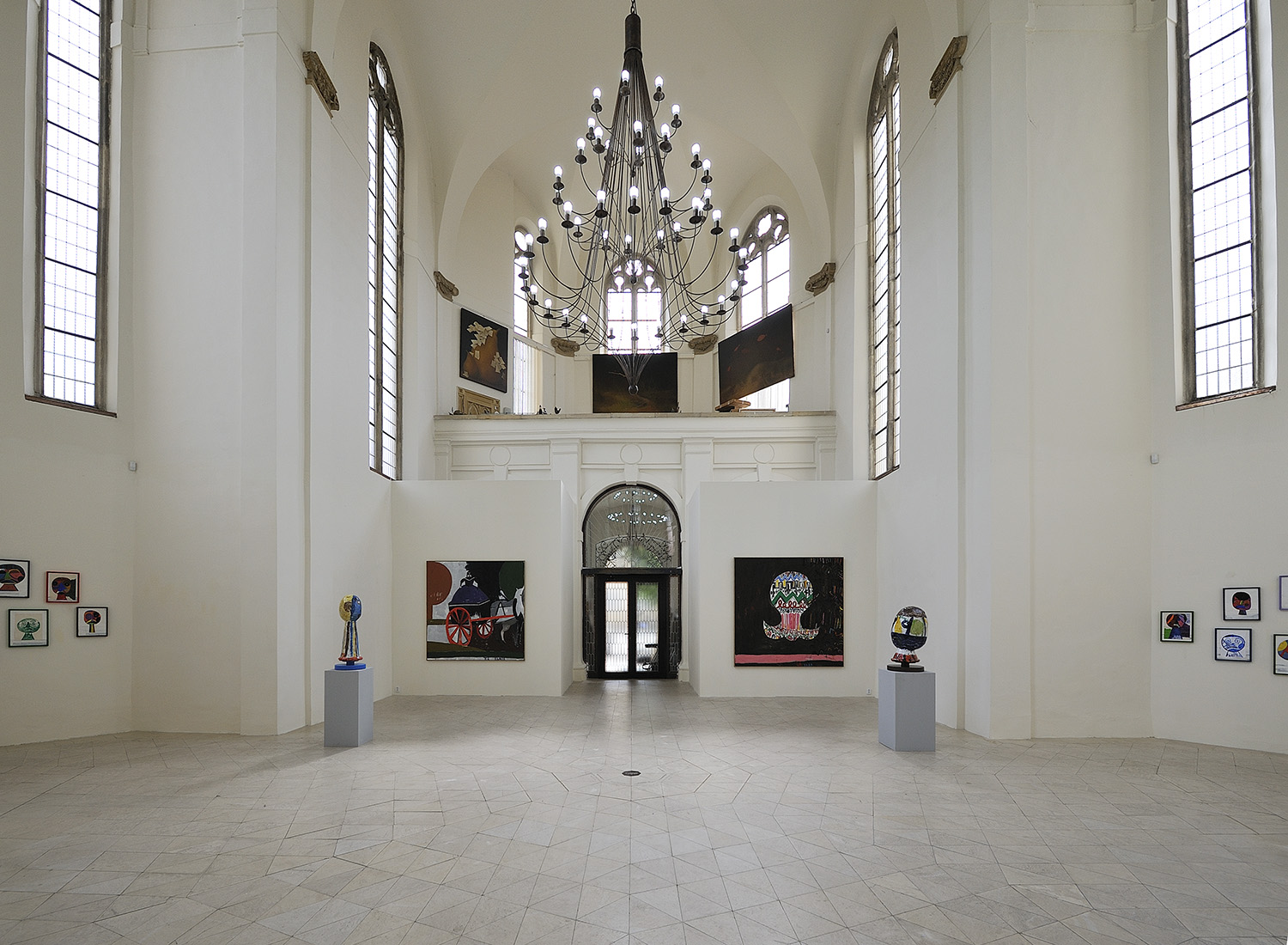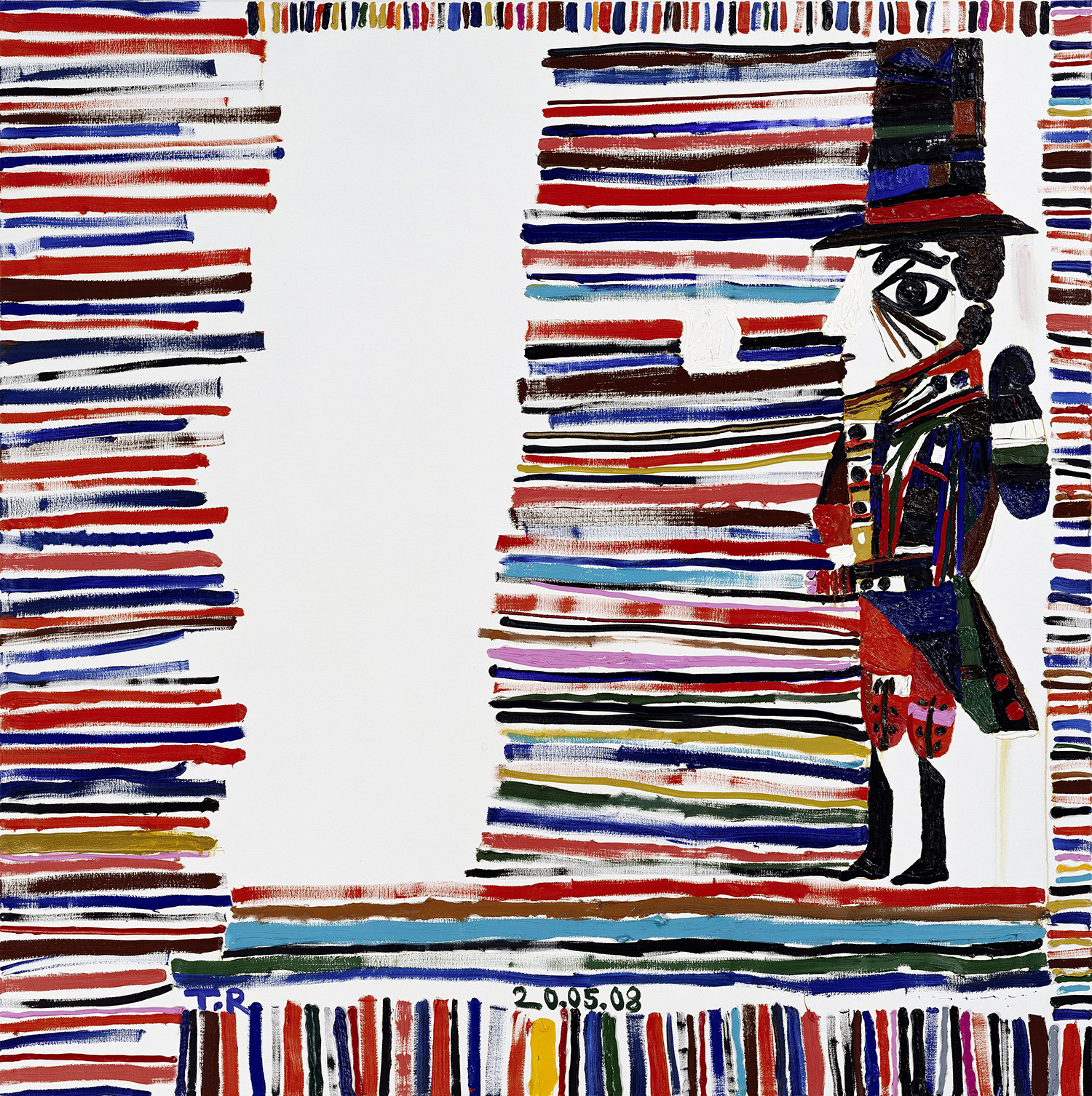A catalogue was published for the exhibition – Tal R katalog
TAL R
For most Western artists, the world on the other side of the former Iron Curtain has seemingly remained cursed. This has also been the case for Tal R. Numerous exhibitions have brought him to galleries around the world, but audiences in the former Eastern Bloc have been able to see his work just once – in Moscow in 2006. The Tal R exhibition at the MIRO Gallery at Prague’s Strahov Monastery is thus a rare opportunity to learn about the work of one of Denmark’s most interesting artists.
Given the sheer abundance of the artist’s work and the limited amount of space at MIRO Gallery, this understandably is not an exhibition that would allow one to become acquainted with the broad scope of the artist’s oeuvre. Instead it is a careful selection of five large and thirty small pictures on a single theme which allow the viewer to learn about his original, creative world. Two glazed ceramic sculptures round out and reaffirm the unity in diversity.
If just the small pictures were exhibited (mixed-media imaginary portraits on paper), their juxtaposition with the ceramic object-portraits would be clear and understandable. Both are the portraits entitled Flovmand (Bashful). The primitively shaped heads – spheres set on cones – are lit up with a range of bright colours. Some are divided by bold lines. Though they may resemble early 20th century cubo-expressionist portraits, the sculpted (or monochrome) representations indicate their lack of plasticity. The shape is very simple; the dominant statement is made through colour. Infinite colour exercises point to the diversity and abundance of man’s experiences and the intensity of our perceptions, but again unity, the uniform expression of Flovmand prevails. There is no existential searching here. They are not masks. Some people are surprised or dumbfounded, yet they remain calm. The Flovmand images are also a social community. Uniformity and perhaps even voluntary discipline prevails over the individualism indicated by diversity. Yet the unifying character of the portraits is primarily the artist’s very own product, something located within him.
And we find that something in the other pictures, though they do not directly relate to the series of portraits. Five large-format pictures draw the viewer into a bigger adventure. Painting is, after all, undoubtedly a spectacular game for the artist. Tal R is usually associated with children’s art, and rightly so. But for Tal R it is more of a process of searching for and finding the child within, the ability to hold on to that magic privilege of always seeing the world with newness and surprise. Many artists who have suffered from creative block found true inspiration by evoking memories of their childhood and perceiving reality differently, and by bringing back their childhood sense for play and fantasy.
Thinking about art and playing with artworks can also be a game. One example is The Wagon, inspired by Henri Rousseau’s Old Man Juniet’s Trap at Musee de l’Orangerie in Paris. Tal R does not paint a variation; he paints it anew, looking at it through his childlike eyes. His perspective is not one of a naivist. Of the several passengers, he picks one – a girl with a strange beast in front of her. The mysterious girl remains the only one on the calash, and the entire carriage is covered by a huge skirt spread out like on one of Velázquez’s (or Picasso’s) ladies-in-waiting. Tal R also drew a red and green drawing depicting this girl in a sort of double fantasy with her mysterious twin on her lap. On the painting exhibited here, though, the girl is alone and is a dark, provincial goddess.
The artist’s game is very open. The spiritual essence of paintings by outstanding artists can be found in his oeuvre – Pablo Picasso, Paul Klee, Henri Matisse, Pierre Bonnard, as well as postmodern inspiration from Bauhaus geometry, expressionist woodcuts, Art brut, the Cobra art group, and even music and comics. Colour almost always remains the main vehicle of information. Form and drawings are often reduced to a symbol, ornament or just a graphic element. A strip of ovals is the balustrade; arches depict waves while other arches are birds. Various coloured dashes placed next to one another are amongst the oldest artistic expressions. And they are typically childlike, still untrained and naïve. The artist’s colour play and balanced composition testify to his visual talent. The picture is always firmly in position; it has a foundation and first horizon line formed by a mere coloured strip cutting the painting in two far at the bottom, almost at the edge of the canvas. Yet this is just a line, not a real horizon – an illusion and a game. This anchor, this firm position, paradoxically also appears in the Bashful portraits, though it is just implied with an almost invisible white drawing or paper collage. The artist calls his painting style kolbojnik, Hebrew for scraps or leftovers.
The ocean paintings are a part of the Teenager Beach series. These were created for an exhibition of the same name held at Centro de Arte Contemporáneo de Málaga in 2009. Tal R studied the original Andalusian environment right at the beach. In return, the museum curator noted the artist’s “artistic origins”, exotic for Andalusians: central European and northern European Neo-Expressionism.
Tal R (born Tal Rosenzweig Tekinoktay) is really connected with these geographic areas, even though his is from Israel, where he was born in 1967. He attended Billedskolen in Copenhagen from 1986 till 1988, and studied at the Royal Danish Academy of Fine Arts from 1994 till 2000.
He has taught at Kunstakademie Düsseldorf since 2005, and has been a guest professor at several schools throughout Scandinavia and northern Germany.
Initially most of his exhibitions were held in Scandinavia and Germany, but later travelled around the world.
Tal R is represented at the Louisiana Museum of Modern Art (Denmark), Essl Museum in Klosterneuburg (Austria), the Goetz Collection in Munich (Germany) and Kunsthalle zu Kiel (Germany).
Petr Štěpán




